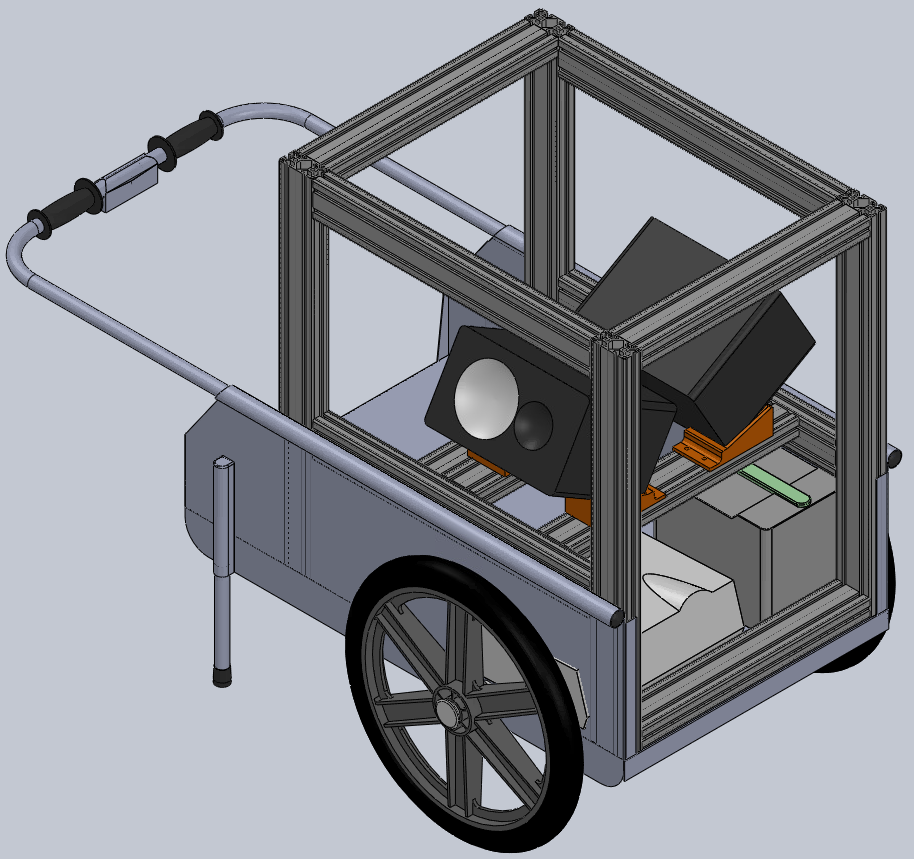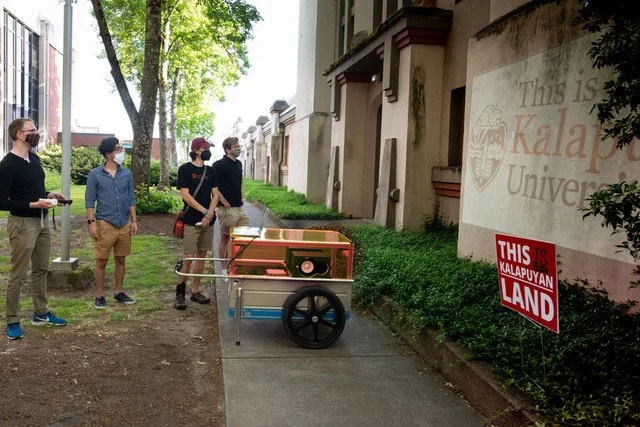Works for Laptop Ensemble
A Laptop . . . Marching band?! [scroll down for more traditional laptop stuff]
My focus as Director (2012 - 2016) of OEDO's Mobile Performance Group was to make a guerrilla-style multimedia collective of electronic musicians and digital artists with one goal: to being new music/art out of traditional concert halls and gallery spaces to pursue audiences in new contexts.
The 2016 performance at SubUrban Projections was an exploration of mobile technologies to explore a marching band approach where spatial audio comes from the performer who is moving around a space as opposed to a traditional expectation of the performer remaining in one place the entire performance. Our laptops and speakers are contained in mesh backpacks for breathability, accessible only through alternative controller instruments. Each musician is able to interact with, play with, and even sabotage other players over a LAN WiFi network exploring a semi cooperative semi competitive battle royale game dynamic of Super Smash Brothers. We each chose character personas from this game as a starting point to explore making music together and against each other.
In the second video, MPG's DangerKart (2015), crafted out of aircraft aluminum and laser-cut plexiglas, is our mobile media command center equipped with portable power, wireless router, wireless audio server, DMX lights, video projector, mixer, and studio monitors. All of our media is site-specific, collected from the location we intend to perform. In this case, all the sights and sounds are from the University of Oregon campus. Creating new wearable technologies, each individual is transformed into a powerful, walking mobile-media platform. Musicians wander around outside and perform with hand-held data-driven instruments that are sonified with wearable bluetooth speakers. They wirelessly send their individual sound to the DangerKart central audio server for analysis, processing, and video interactivity. All MPG members are synchronized through a sophisticated wireless music network system to play in tempo and in the same key.
I was founding director of the Oregon Electronic Device Orchestra at the University of Oregon from 2012 - 2016. This was a cross-listed grad/undergrad laptop ensemble with changing themes each Fall, Winter, and Spring Term.
The works in this section feature performances for circuit-bent instruments. Circuit bending is the practice of adapting devices like toys that make sound to create new musical instruments through voiding product warranties, exploring circuitboards using hands and probes, hacking, rewiring, and reimagining. An entire instrument, from how it is physically performed, the sounds it makes, to the role it will play in the ensemble all must be designed. Students have just 4 weeks to accomplish this. We all spend the following 3 weeks together rehearsing a piece to performs as an ensemble together on stage.
The stage lights behind each performer is programmed to correspond to the volume and timbre of the corresponding performer to provide extra visual feedback to the audience about whom is playing what.
Laptops are used to process and extend the dynamics of their hacked toy’s sonic expression using audio processing. This helps add additional expressive elements to shape and perform with others on stage.
Networked Alternative Controllers
We explore the concept of networked “Entangled” instruments using laptops. Entangled instruments are like one giant instrument that requires the input of many simultaneous performers each controlling various parameters of the large instrument. Players my be collaborative and operate complimentary parameters together, or competitive and assert their control over a parameter from someone else. We explore group, game, and social dynamics within the ensemble as structural elements for our performance. Alternative controllers are devices and human-computer interfaces used as musical instruments. They can be pre-existing commercial products like game controllers, or designed from scratch using sensors and other electronic components. Students have 4 weeks to design and produce their instruments from these controllers, and then 3 weeks to rehearse together to perform an ensemble piece on stage.
Laptops not only translate the individual controller information of each performer into their musical representation, but performance data of each performer is also transmitted on a shared network for all players to potentially use as well.
BEAVR | Big Electronic Audio-Visual Rover
During the COVID-19 pandemic, Oregon State Students and I designed BEAVR: Big Electro Audio-Visual Rover. The idea is to be able to roll up virtually anywhere a bike can go and have a powerful performance studio and installation gallery space right there with you. It is particularly well suited for out-door and ad-hoc socially-distanced environments. It uses a fold-it cart and fold-able aluminum extrusion frame that can either be hand pulled or hitched to a bike and compressed into a tight car trunk for transport. Laser-cut and etched neon orange acrylic plexiglas is not only on-brand but also serves to form the structure for inserting: ultra-bright short-throw projector, audio system, RGB stage light, wireless router for transmitting realtime performance data for interactivity, laptop computers, and portable power with wall-plug and solar possibilities. This is a re-boot of an older design some students and I came up with at the University of Oregon in 2015.

